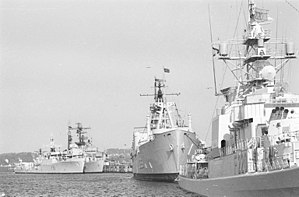 HMS Murray (left) visiting Kiel, Germany, in 1967 HMS Murray (left) visiting Kiel, Germany, in 1967
| |
| History | |
|---|---|
| Name | HMS Murray |
| Namesake | George Murray |
| Builder | Alexander Stephen and Sons, Govan |
| Laid down | 30 November 1953 |
| Launched | 25 February 1954 |
| Commissioned | 5 June 1956 |
| Identification | Pennant number: F91 |
| Fate | Broken up 1970 |
| General characteristics | |
| Class and type | Blackwood-class frigate (Type 14 frigate) |
| Displacement | 1,456 long tons (1,479 t) full load |
| Length | 310 ft (94.5 m) |
| Beam | 33 ft (10.1 m) |
| Draught | 15 ft (4.6 m) |
| Installed power |
|
| Propulsion | 1 shaft; 1 steam turbine set |
| Speed | 27 knots (50 km/h; 31 mph) |
| Range | 5,200 nmi (9,600 km; 6,000 mi) at 12 knots (22 km/h; 14 mph) |
| Complement | 140 |
| Sensors and processing systems |
|
| Armament |
|
HMS Murray (F91) was one of a dozen Blackwood-class frigate (also known as the Type 14 class) of second-rate anti-submarine frigates built for the Royal Navy in the 1950s. She was named for George Murray, who served during the late 18th and early 19th centuries.
Description
The Blackwood class displaced 1,180 long tons (1,200 t) at standard load and 1,456 long tons (1,479 t) at deep load. They had an overall length of 310 feet (94.5 m), a beam of 33 feet (10.1 m) and a draught of 15 feet (4.6 m). The ships were powered by one English Electric geared steam turbine that drove the single propeller shaft, using steam provided by two Babcock & Wilcox boilers. The turbine developed a total of 15,000 shaft horsepower (11,000 kW) and gave a maximum speed of 27 knots (50 km/h; 31 mph). The Blackwoods had a range of 4,500 nautical miles (8,300 km; 5,200 mi) at 12 knots (22 km/h; 14 mph). Their complement was 140 officers and ratings.
The ships were armed with three Bofors 40 mm guns in single mounts. The mount on the quarterdeck was later removed as it was unusable in heavy seas. They were equipped with two triple-barrelled Limbo Mark 10 anti-submarine mortars. The Blackwood-class ships had the same sonar suite as the larger Whitby-class frigates where the Limbo mortars were controlled by three sonars, the Type 174 search set, Type 162 target-classification set and the Type 170 'pencil beam' targeting set to determine the bearing and depth of the target.
Construction and career
Murray was laid down by Alexander Stephen and Sons at their Govan shipyard on 30 November 1953, launched on 25 February 1954 and completed on 5 June 1956. The ship is featured with other Type 14 frigates in the 1960 Norman Wisdom film The Bulldog Breed. The ship was also shown working with coastal command, practicing submarine hunting, in a coastal command training film from the 1950s.
Notes
- Marriott, p. 66
- Gardiner, Chumbley & Budzbon, p. 515
- Marriott, pp. 55, 66, 69
Bibliography
- Colledge, J. J.; Warlow, Ben (2006) . Ships of the Royal Navy: The Complete Record of all Fighting Ships of the Royal Navy (Rev. ed.). London: Chatham Publishing. ISBN 978-1-86176-281-8.
- Critchley, Mike (1986). British Warships Since 1945: Part 5: Frigates. Liskeard, UK: Maritime Books. ISBN 0-907771-13-0.
- Friedman, Norman (2006). British Destroyers and Frigates, the Second World War and After. Annapolis, Maryland: Naval Institute Press. ISBN 1-86176-137-6.
- Gardiner, Robert; Chumbley, Stephen & Budzbon, Przemysław (1995). Conway's All the World's Fighting Ships 1947-1995. Annapolis, Maryland: Naval Institute Press. ISBN 1-55750-132-7.
- Marriott, Leo (1983). Royal Navy Frigates 1945-1983. Shepperton, Surrey, UK: Ian Allan. ISBN 0-7110-1322-5.
| Blackwood-class frigates | |
|---|---|
| |